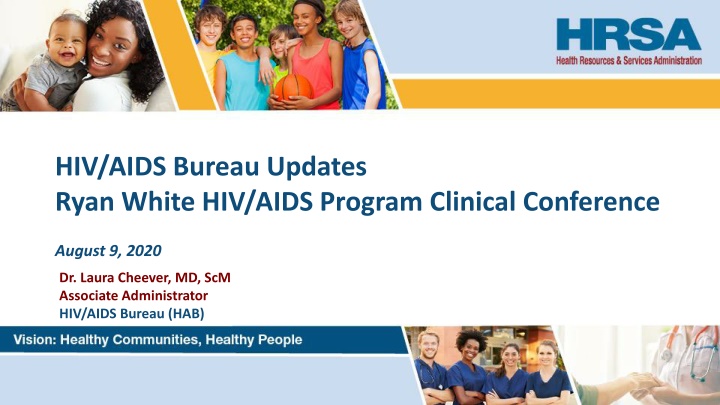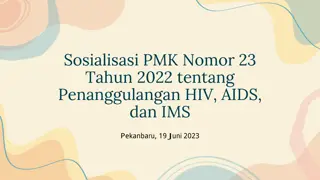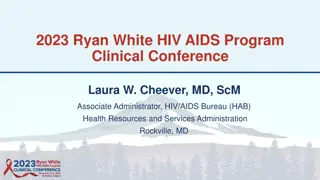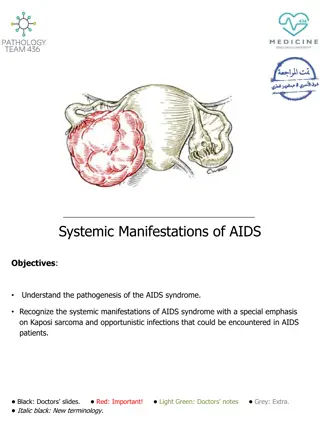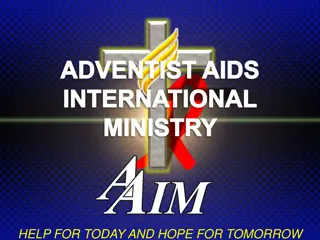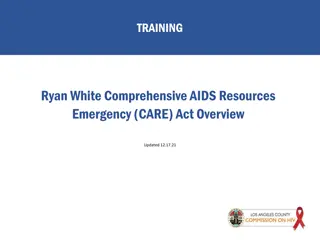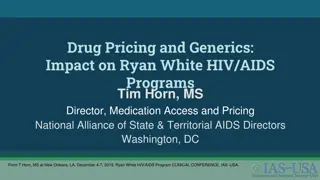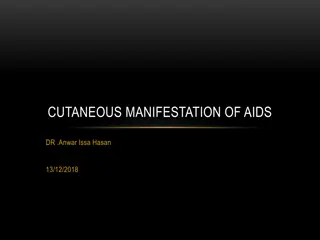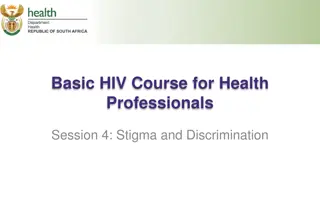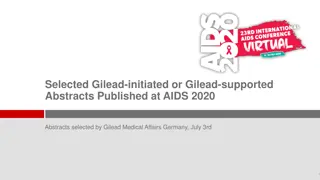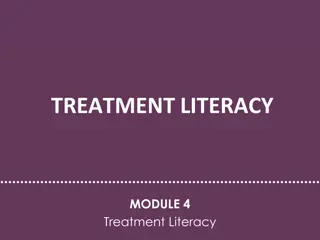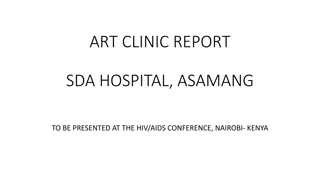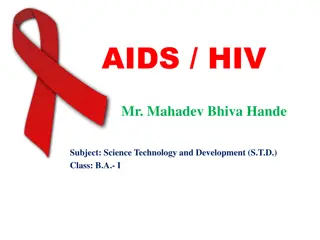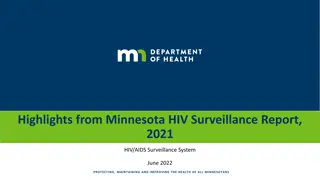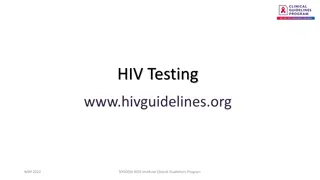HRSA HIV/AIDS Bureau Updates - August 2020 Conference Highlights
The HRSA HIV/AIDS Bureau presented updates on the Ryan White HIV/AIDS Program, focusing on viral suppression data, key populations served, and strategies for ending the HIV epidemic. The conference emphasized the importance of optimal care, treatment access, and prevention methods to combat HIV/AIDS effectively.
Download Presentation

Please find below an Image/Link to download the presentation.
The content on the website is provided AS IS for your information and personal use only. It may not be sold, licensed, or shared on other websites without obtaining consent from the author.If you encounter any issues during the download, it is possible that the publisher has removed the file from their server.
You are allowed to download the files provided on this website for personal or commercial use, subject to the condition that they are used lawfully. All files are the property of their respective owners.
The content on the website is provided AS IS for your information and personal use only. It may not be sold, licensed, or shared on other websites without obtaining consent from the author.
E N D
Presentation Transcript
HIV/AIDS Bureau Updates Ryan White HIV/AIDS Program Clinical Conference August 9, 2020 Dr. Laura Cheever, MD, ScM Associate Administrator HIV/AIDS Bureau (HAB)
HRSAs HIV/AIDS Bureau (HRSA HAB) Vision and Mission Vision Optimal HIV/AIDS care and treatment for all. Mission Provide leadership and resources to assure access to and retention in high quality, integrated care, and treatment services for vulnerable people with HIV and their families. 2
2018 Client-Level Data Continued Progress
Viral Suppression among Clients Served by the Ryan White HIV/AIDS Program (non-ADAP), 2010 2018 United States and 3 Territoriesa Viral suppression: 1 OAHS visit during the calendar year and 1 viral load reported, with the last viral load result <200 copies/mL. a Guam, Puerto Rico, and the U.S. Virgin Islands.
Viral Suppression among RWHAP Clients, by State, 2010 and 2018 United States and 2 Territoriesa Viral suppression: 1 OAHS visit during the calendar year and 1 viral load reported, with the last viral load result <200 copies/mL. a Puerto Rico and the U.S. Virgin Islands.
Viral Suppression among Key Populations Served by the Ryan White HIV/AIDS Program, 2010 and 2018 United States and 3 Territoriesa Hispanics/Latinos can be of any race. Viral suppression: 1 OAHS visit during the calendar year and 1 viral load reported, with the last viral load result <200 copies/mL. a Guam, Puerto Rico, and the U.S. Virgin Islands.
Ending the HIV Epidemic Identifying and Addressing Challenges
Four Pillars of Ending the HIV Epidemic Diagnose All people with HIV as early as possible. Treat People with HIV rapidly and effectively to reach sustained viral suppression. Prevent New HIV transmissions by using proven interventions, including pre- exposure prophylaxis (PrEP) and syringe services programs (SSPs). Respond Quickly to potential HIV outbreaks to get needed prevention and treatment services to people who need them. 8
Geographic Locations of Ending the HIV Epidemic Initiative Efforts focused in 48 counties, Washington, DC, and San Juan, PR, where more than 50% of HIV diagnoses occurred in 2016 and 2017, and seven states with substantial rural HIV burden. County contributing to 50% new HIV diagnoses in 2016/2017 State with disproportionate rural burden in 2016/2017 9
Ending the HIV Epidemic Overlap of RWHAP Parts A and B and Identified Counties and States
Identifying the Challenges Ahead People newly diagnosed with HIV People with HIV out of care People with HIV in care Enhance linkage to care Enhance engagement in care Expand re- engagement in care Improve retention in care Improve viral suppression rates Decrease disparities 11
HRSA HAB Ending the HIV Epidemic (EHE) Resources FY 2020 $70 million JURISDICTIONS Ryan White HIV/AIDS Program Parts A and B COMMUNITY ENGAGEMENT SYSTEMS COORDINATION TA AND CAPACITY BUILDING Technical Assistance Provider Systems Coordination Provider AIDS Education and Training Center (AETC) Program for workforce capacity development 12
FY 2020 Minority HIV/AIDS Fund Initiatives to Support EHE Reducing Stigma at Systems, Organizational, and Individual Client Levels in the Ryan White HIV/AIDS Program Building Capacity to Implement Rapid Antiretroviral (ART) Initiation for Improved Care Engagement Improving Care and Treatment Coordination: Focusing on Black Women with HIV 13
HRSAs Health Center Program Funding Overview Primary Care HIV Prevention (PCHP) Supplemental Funding $54 million awarded to 195 HRSA-funded health centers with service delivery sites in the geographic locations identified by the EHE. Recipients: dually-funded (HRSA s Bureau of Primary Health Care and RWHAP) health centers or health centers with MOUs with RWHAP sites PCHP OBJECTIVES Increase patients tested for HIV Engage new and existing patients to identify those at risk for HIV Increase patients who receive prevention education and clinically- indicated PrEP Enhance/Establish partnerships to support HIV prevention activities Within 8 months of award, add staff to support HIV prevention services and PrEP Increase linkage to HIV treatment 14
HRSA COVID-19 Related Funding and Awards HRSA Program Month/Purpose Total Awards Health Center Program March: Health Centers April: Health Centers May: Health Centers July: Health Center Look A-likes $100 million $1.3 billion $583 million $17 million Ryan White HIV/AIDS Program April: Ryan White HIV/AIDS Program $90 million Federal Office of Rural Health Policy April: Rural hospitals May: Rural Health Clinics May: Tribal and urban Indian health orgs., other health services providers to tribes $150 $225 $15 million Poison Control Centers Program April: Poison control centers $5 million Telehealth Investments April: BHW: Health workforce programs- telehealth training April: MCHB: Maternal and child health April: Telehealth Resource Centers Sept: Assist telehealth clinician on licensure and credentialing $15 million $15 million $11.5 million $ 5 million Provider Relief Fund Ongoing: to Health Care Providers and Facilities for expenses and lost revenue, including Uninsured Program $177 billion 16
COVID- Related Funding for RWHAP: $90 million Awarded to 581 RWHAP recipients of CARES Act funding on April 15, 2020 Funding to Parts A, B, C, D, AETCs Prevent, prepare for, and respond to COVID-19 for RWHAP clients. Examples: PPE, minor renovations COVID testing, treatment Telemedicine infrastructure, phone minutes Housing, transportation, emergency food Staff training, patient education Provides flexibility to meet evolving needs for people with HIV related to COVID-19 75% Core medical services waived 50% EIS in Part C waived Pre-award costs back to January 20, 2020 17
HAB COVID Activities Communication ~Monthly RWHAP recipient HAB You Heard webinars Web page to centralize information Extending deadlines Grant applications, reporting Delaying Part C re-competition by one year Responding to questions and providing guidance Daily incoming FAQs Delaying site visits Considerations of retention rates and pay-for performance Frequently Asked Questions can be found at: https://hab.hrsa.gov/coronavirus/frequently- asked-questions Working with Federal counterparts HHS Treatment Guidelines Committee Guidance 18
COVID-19 Lessons to Accelerate EHE Response Adoption of telemedicine o Reaching those out of care o Improving retention rates o Concerns about the digital divide Extension of medication refills o 90 day fills o Increased home delivery Self Testing o HIV, STIs Reassessing processes o Eligibility and recertification 19
Technical Expert Panels Topic Date Addressing the Housing Needs of RWHAP Clients November 18, 2019 Addressing the HIV Care Needs of People with HIV who are Justice Involved March 3, 2020 Part D Reimagine April 2, 2020 Assessing Implementation and Impact of RWHAP Rapid Eligibility Determination and Six-Month Recertification Policies and Procedures February 19, 2020 (ADAP) February 20, 2020 (Parts A & B) June 17-18, 2020 (Parts C & D) Aging with HIV November 17 & 18, 2020 October 14, 21, & 28, 2020 (tentative dates) Enhancing HIV Prevention and Care for Women 20
Other Key Activities 2020 Addressing the implementation gap Evidence Informed Interventions (e2i) Compilation of Promising Practices Capacity building to support innovative program model replication Focusing on STIs Extragenital testing Data Eliminating HCV co-infection Better utilizing data for decision making 21
Thank you for all you do in your communities on behalf of people with HIV 22
Contact Information Connect with HRSA Laura Cheever, MD, ScM Associate Administrator HIV/AIDS Bureau (HAB) Health Resources and Services Administration (HRSA) Email: Lcheever@hrsa.gov Phone: 301-443-1993 Web: hab.hrsa.gov Learn more about our agency at: www.HRSA.gov "" Sign up for the HRSA eNews FOLLOW US: YouTube Twitter Facebook Instagram Instagram 23
